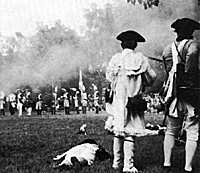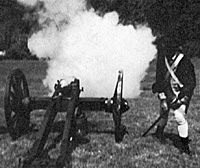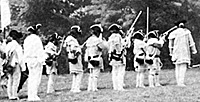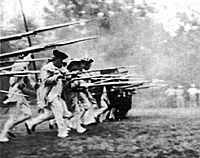Contrary to popular belief the American War for Independence was not won by the sharp-shooting minuteman hiding behind a tree, wall or fence ambushing the unsuspecting British solider. While the early stages of the conflict were fought in this manner (most notably Lexington and Concord in 1775), this was dictated by the total lack of military organization of the Americans at that point in time. As the war progressed, more discipline and professionalism was introduced into the fledgling army. Virtually all of the major American victories were accomplished by the execution of the accepted manner of warfare of the eighteenth century -- linear tactics.
 The metamorphosis of the Continental Army
can be seen by comparing the swarming,
disorganized attacks of the minuteman during the
British withdrawal from Concord Bridge and the
manner in which the American militia fought at the
Battle of Bennington, Vermont in 1777 (which
incidentally was fought in New York State). The
marked improvement in American fighting
effectiveness produced a victory at Bennington, but
the transition to European linear tactics became
complete during the Winter of 1777-1778 when
Baron Frederick von Steuben trained the Continental
Army in the tactics he had been taught as a Prussian
staff officer for Frederick the Great during the Seven
Year's War.
The metamorphosis of the Continental Army
can be seen by comparing the swarming,
disorganized attacks of the minuteman during the
British withdrawal from Concord Bridge and the
manner in which the American militia fought at the
Battle of Bennington, Vermont in 1777 (which
incidentally was fought in New York State). The
marked improvement in American fighting
effectiveness produced a victory at Bennington, but
the transition to European linear tactics became
complete during the Winter of 1777-1778 when
Baron Frederick von Steuben trained the Continental
Army in the tactics he had been taught as a Prussian
staff officer for Frederick the Great during the Seven
Year's War.
This final transition to European linear tactics produced the major Continental victories from the campaign of 1778 through the ultimate victory at Yorktown, Virginia in 1781.
 "Artillery was not massed. . .but rather used In a support
tunctlon tor Intantry." This and all photos by the author.
"Artillery was not massed. . .but rather used In a support
tunctlon tor Intantry." This and all photos by the author.
The linear style of warfare received its major refinement during the Seven Year's War was modified to adapt to the North American terrain during the Revolution and reached its grandest form during the Napoleonic Wars. It required great discipline of the troops, whose commanders were committed to using it. This article is only concerned with the use, modification, and implementation of linear warfare on the North American Continent during the American Revolution
The opposing armies that fought in the linear style would approach the battlefield in column, generally four men abreast. The march was to a slow cadence usually sixty beats per minute -- the French, however, had a slightly faster cadence. March columns were in close order, and all troops (not just the Hessians) marched in a modified goose- step. Upon arriving at the battlefield, the armies would swing from columd into a single or double line.
 From this point, the two armies would close with one another and the major fighting would begin at about fifty yards. Generally speaking, an experienced commander would hold his first volley as long as he could, until the enemy was as close as possible. In this manner, his volley would be the most effective. These tactics were dictated by the effectiveness of the weapons of the period and the manner in which they were employed.
From this point, the two armies would close with one another and the major fighting would begin at about fifty yards. Generally speaking, an experienced commander would hold his first volley as long as he could, until the enemy was as close as possible. In this manner, his volley would be the most effective. These tactics were dictated by the effectiveness of the weapons of the period and the manner in which they were employed.
The most commonly used weapon was the English Brown Bess Musket, which ranged from .69 to .71 caliber and had a smooth-bore barrel. Other popular muskets of this period included the French Charleville and the American Committees of Safety Musket. The musket was rarely very accurate over 25 yards. Troops would usually march shoulder to shoulder and attempt to volley simultaneously, massing their firepower. While musketry began very often at ranges of fifty to seventyfive yards, the greatest blow could be dealt the enemy by disciplined fire at close range.
After several volleys, one side would charge the other and the hand-to-hand melee would decide who carried the day. Very often the volleys of musketry were solely for shock value to demoralize or disorganize the enemy and thus aid the bayonet charge. The bayonet was the ultimate weapon of the American Revolution. The majority of battlefield casualties fell victim to the blade. Superior use of the bayonet in a melee would often determine who would carry the day.
 "Troops would march shoulder to shoulder and attempt to volley simultaneously, massing thelr firepower."
"Troops would march shoulder to shoulder and attempt to volley simultaneously, massing thelr firepower."
A weapon that was in many ways superior to the musket, the rifle, was not utilized to the extent of the musket by either side. The rifle had a much longer effective range than the musket and was extremely accurate. In comparison to the musket, the rifle generally was of a lower caliber.
The American made Pennslyvania long rifle generally averaged between .40 and .60 caliber, while the German made Jaeger rifle ran .60 to .70 caliber. The weapon fell into disfavor with George Washington for two major reasons: it took longer to load than the musket, fired less rounds per minute, and a bayonet could not be mounted on it. Like most new weaponry, the rifle received peripheral usage in comparison to the traditionally accepted weapon, the musket.
Artillery was not massed as in the Napoleonic period, but rather it was used in a support function for infantry. As the opposing sides were drawn up for battle, the artillery would begin an individual barrage at about 300 yards and continue throughout the battle as ammunition, visibility, and the ebb and flow of battle allowed. Interestingly enough, horse artillery was not used to any great extent. Frederick the Great had developed the horse artillery concept, yet it fell into disuse until the Napoleonic Wars.
 "The bayonet was the ultimate weapon of the American Revolution.
"The bayonet was the ultimate weapon of the American Revolution.
During the Seven Year's War in Europe, the development of linear warfare also saw a sophistication in the use of cavalry in conjunction with infantry and artillery. Frederick the Great demonstrated this technique with his heavy cavalry in 1756 at Lobositz. Unlike Europe's open rolling farmlands, America's dense forests and rockey terrain seriously limited the use of cavalry. An avid military historian will find some minor exceptions to this in the Southern Campaigns, particularly from 1780 to 1781. However, there were no great masses of heavy cavalry employed as was done in Europe during the Seven Year's War.
If one is to develop an accurate recreation of the military tactics of the American War for Independence, the general outline above should be considered in deployment and utilization of troops and terrain. While many exceptions to the rule can be found, that which is represented here is a generalization drawn from the hundreds of battles and skirmishes that took place in American from 1775-1781, and should be considered as such.
SOURCES
Cumming, William P and Rankin, Hugh, Fate of a
Nation, London, Phaidon Press, 1976.
Mitchell, Lt. Col Joseph B, Decisive Battles of the
American Revolution, Greenwich, Connecticut, Fawcett
Books, 1962.
Neumann, ceorge c., The History of Weapons of the
American Revolution, New York, Bonanza Books, 1967.
Scheer, George F and Rankin, Hugh, Rebels and
Redcoats New York, World Publishing Company, 1967
Steuben, Frederick, Regulations for the Order and Discipline
of the Troops of the United States, Philadelphia, Styner and
Cist, 1779.
Wallace, Willard, Appeal to Arms, Chicago,
Quadrangle Books'
Wheeler, Richard, Voices of 1776, Creenwich,
Connecticut, Fawcett Books, 1972.
Rebuttal: Letters to Editor v2n2
Back to Table of Contents -- Courier Vol. 1 #5
To Courier List of Issues
To MagWeb Master Magazine List
© Copyright 1980 by The Courier Publishing Company.
This article appears in MagWeb (Magazine Web) on the Internet World Wide Web.
Other military history articles and gaming articles are available at http://www.magweb.com